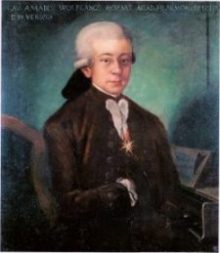Three months ago, in my post of September 30, I linked to a video of pianist Maria João Pires expecting to play one Mozart concerto, only to discover that the conductor had a completely different one in mind. That Ms. Pires was able to recover from the shock and play the second concerto – without the score – speaks volumes about her memory, and her presence of mind as well.
Having listened to her magnificent performance of the “surprise” concerto, I now want to present Ms. Pires performing the concerto she was expecting to play that day: Mozart’s Concerto No. 9 in E-flat, now called the “Jenamy”. But first, a word about its subtitle, courtesy of Wikipedia:
The work has long been known as the Jeunehomme Concerto. [In fact, that’s how I referred to it in September. – DR] Théodore de Wyzéwa and Georges de Saint-Foix claimed that Mozart wrote the piece for a French pianist ‘Jeunehomme’ visiting Salzburg. This name is however incorrect; in 2004 Michael Lorenz demonstrated that the name was actually Victoire Jenamy (1749–1812), a daughter of Jean-Georges Noverre, a dancer who was one of Mozart’s friends. Mozart had made Victoire Jenamy’s acquaintance during his stay in Vienna in 1773.
The interested reader will find much more information online from Michael Lorenz about discovering the correct subtitle for this concerto, but more interesting to me is what he has to say about the piece itself:
Mozart’s Piano Concerto K. 271 “Jenamy” can be described as a miracle of musical originality. In the mastership of its orchestration, its stupendous innovative energy and its effect, despite limited instrumental means, this piece has absolutely no precedent. It is Mozart’s first great composition, “his Eroica” as Alfred Einstein put it, “which he later would match, but never surpass.”
I can add little to that, except to say that this concerto is a joy from beginning to end. Listening to it, I am struck over and over by the charm and elegance of the first movement, the surpassing tenderness of the second, and the jaunty exuberance of the third, which seems to go on and on in an ecstasy of imagination. I’m especially grateful for the glorious sound in the attached video, in which John Eliot Gardiner conducts the Vienna Philharmonic Orchestra.
The three movements of the concerto, and their start times in the video, are as follows:
1. Allegro – 0:09
2. Andantino – 10:43
3. Rondo (Presto); Menuetto (Cantabile) – 22:06
